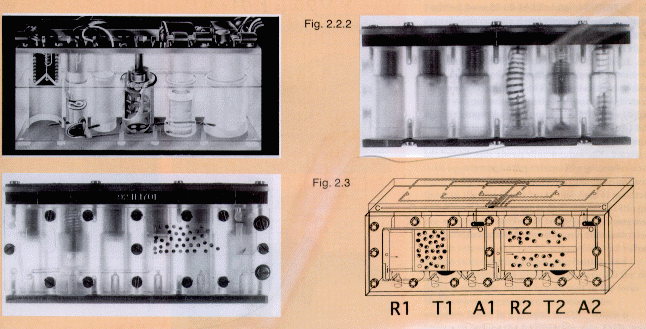
Experiment Modules
When performing space flight or 'ground
based research' it is necessary to accommodate your samples in a system that
is compatible with such an experimental environment. A first thought might be
that when the sample / experiment can be held upside down without loosing its
content it is pretty much 'compatible' with a microgravity environment. Although
this does not cover all the requirements you would have to fulfill to fly an
experiment in a sounding rocket or on board Shuttle or the International Space
Station, ISS, it at least starts you thinking about the issue.
One of the other issues in real microgravity, or better near weightlessness,
studies is the limited volume available to perform such experiments. In biology
one of the most common handlings performed during regular tissue and cell culture
experiments is changing fluids. This encompasses refreshing media after some
time to maintain the cells, add activators or other cytokines and cell modulators
that are the subject of study. After a certain incubation period the substance
has to be removed and changed by fresh medium again or cells have to be fixed
for later protein / RNA / DNA analysis of morphological studies. All these steps
involve the change of liquids around the cells or tissues.
In regular laboratory practice we have our samples in petri dishes or comparable systems like multiwell plates or cell culture flasks and these are the preferred 'containers' for 'ground-based' experiments. Although these systems can be used for centrifuge hypergravity experiments they will not, as mentioned earlier, function under other conditions such as simulated micrigravity. In general we need special hardware (H/W) for this.
Plunger Boxes
Within the Netherlands there is a
long standing tradition building small experiment modules for spaceflight studies.
One of the first of such experiment boxes were developed by CCM (Nuenen, The
Netherlands) in collaboration with dr. Geert Ubbels from the Hubrecht laboratory
in Utrecht. It flew in the Biorack facility on board the Shuttle D-1 mission
in 1985. These so called 'plunger boxes' (size 20×40×80 mm) were
able to perform a completely automated fertilization of amphibian eggs under
microgravity conditions. The first fertilization ever under microgravity conditions
was performed in this plunger box in the Texus-17 sounding rocket flight in
1988. See Figure XX for a picture of this plunger
box system. (See also the 'Publication' pages for
references to these studies). After the first flight, similar or slightly modified
versions of this systems have been used since.
 |
Figure
1: First plunger box configuration as has been used by Ubbels et al. for
the fertilization of Xenopus eggs under microgravity conditions
|
LIDIA
modules
In 19XX Dutch Space (former Fokker Space) (Leiden, The Netherlands) drafted a slightly
different system called the LIDIA. In principle the tasks that can be performed
by this LIDIA are comparable to the plunger bozxes. One main difference is that
the LIDIA is capable to be activated many times while some components in the
plunger boxes were specifically designed to perform once, namely in flight.
This opened the possibility to test the LIDIA modules before flight and also
to use the same H/W during ground based preparative studies.
The dimensions of the LIDIA is 20×40×80 mm a standard size for ESA
Type-I experiment containers (see for details
the Biopack page) as they were and are used in the Biorack, Biopack,
CIS and Biobox facilities.
These modules are designed to be used for flight eperiments but may also be used for on ground research using microgravity simulators such as the Random Positioning Machine (RPM) and the Free Fall Machine (FFM) or centrifuges such as the MidiCAR. You can perform pre-programmed or manually commanded fluid handling procedures while running the experiment in a particular facility.
Click to start a short animation of the LIDIA experiment container.